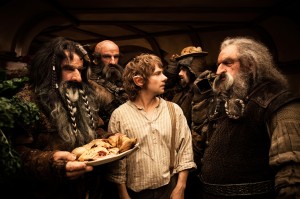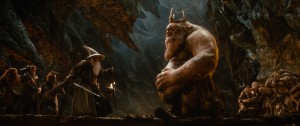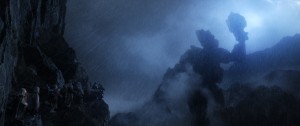Even if you’ve been living under a rock in a troll cave for the past nine years, you have to be at least somewhat familiar with J. R. R. Tolkien‘s The Hobbit and the massive film trilogy Peter Jackson has been putting together for the past several years. And if you’ve read any of the early reviews of the first installment, The Hobbit: An Unexpected Journey, it seems that there are many criticisms for this prequel to Jackson’s The Lord of the Rings trilogy that garnered both critical acclaim and enormous financial achievements.

Bifur (William Kircher), Dwalin (Graham McTavish), Bilbo Baggins (Martin Freeman), Bofur (James Nesbitt) and Oin (John Callen) have one last supper before their "Unexpected Journey." Photo by James Fisher.
From questions of why Jackson would turn a relatively short novel into a sprawling trilogy of films that are almost three hours each to complaints about his decision to present the film at 48 frames per second (a much higher frame rate than most films, resulting in a much clearer presentation), it seems that The Hobbit is fighting an uphill battle from the very beginning. But from the moment the high frame rate images hit the screen, I realized this film would be more impressive than most people were expecting.
As was often referenced in The Lord of the Rings, the story of Middle-earth’s biggest battle actually begins 60 years earlier when a young Bilbo Baggins (Martin Freeman) is visited by Gandalf the wizard (Ian McKellen). After a perplexing exchange, 13 dwarves (slovenly warriors with meticuously manicured facial hair) show up later that night to thoroughly disrupt not only Bilbo’s otherwise-routine dinner, but ultimately the rest of his life. After pillaging his food pantry and unnerving Bilbo with their seemingly careless treatment of his belongings, the dwarves set out to reclaim their kingdom from Smaug, a magnificent dragon that has taken over the dwarves’ home of Erebor and all of its treasures.

The Great Goblin (Barry Humphries) isn't going to let Gloin (Peter Hambleton), Ori (Adam Brown), Nori (Jed Brophy) and Gandalf (Ian McKellen) escape without a fight. Photo courtesy of Warner Bros. Pictures.
As you might expect, this Unexpected Journey isn’t a simple one. And since hobbits aren’t typically the most adventurous creatures in Middle-earth, Bilbo constantly finds himself being doubted by Thorin Oakenshield (Richard Armitage), the dwarf leader who has some very personal issues with the orcs that are hunting his party, as well as the elves who eventually aid him in his quest. This turmoil not only creates constant in-fighting, but it also makes confrontations with orcs, goblins, trolls and other creatures that much more meaningful.
An Unexpected Journey sees the return of Cate Blanchett and Hugo Weaving as highly-regarded elven leaders, Elijah Wood as the young relative of Bilbo, Ian Holm as the older Bilbo and chillingly foreboding appearances by Christopher Lee as Saruman and Andy Serkis as the emaciated Gollum. There’s plenty of foreshadowing, given what we’ve already seen of these characters in The Lord of the Rings, but there’s also a lot of anticipation of how these characters will develop into the villains we know them to become.
As far as the high frame rate presentation of this movie, I really can’t comprehend what there is to complain about. Not only does it make The Hobbit look incredibly realistic, but it’s also impressive to find that the extra clarity doesn’t reveal any flaws in the special effects and computer-animated elements.
And even though there are several superfluous scenes in this film, some of those moments make for the most breath-taking sequences in the movie, such as when gigantic rock creatures do battle in a canyon (verifying myths about the origins of thunderstorms) and the entire capture-by and escape-from the cavern-dwelling goblins (where Bilbo initially meets Gollum, and inadvertently obtains the cursed ring). There’s also an edge-of-your-seat showdown between the pursuing orcs and the dwarves during which Bilbo finally earns the respect of Thorin, and the heroic eagles make their first appearance (with every strand of each feather fluttering realistically in the wind). And as An Unexpected Journey nears its end (which really isn’t an end at all since there are two more epic films in the trilogy), one can’t help but laugh at Bilbo’s ironic proclamation of “I do believe the worst is behind us.”

